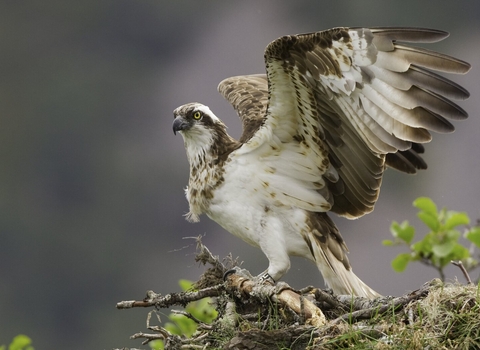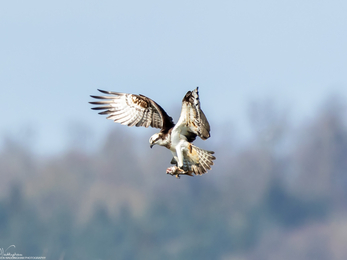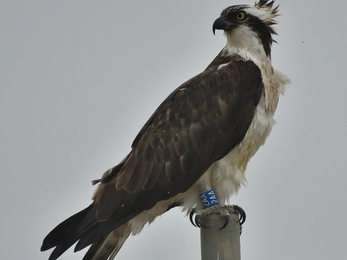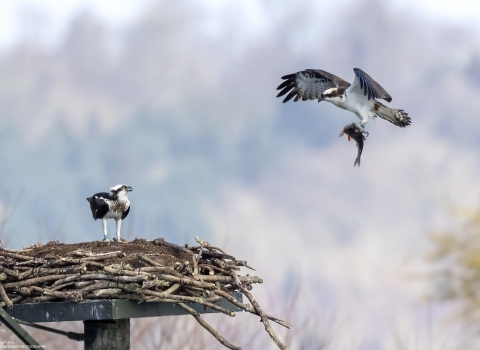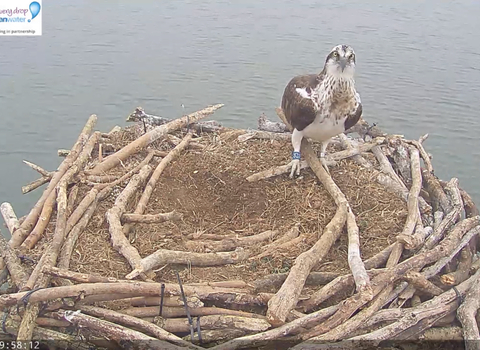World Osprey Week
World Osprey Week celebrates ospreys as they make their spring migrations to their nesting grounds. Founded by Leicestershire and Rutland Wildlife Trust, this week-long event aims to enthuse and educate people, in particular children, about this brilliant bird of prey. From tracking treacherous migrations, to understanding their repopulation of Scotland, World Osprey Week provides an opportunity to weave the excitement of ospreys into learning about geography, history and science. Scroll down to learn more about these amazing birds!
World Osprey Week Daily Activities
If you missed any of World Osprey Week, you can catch up on all the daily activities and digital packs below. Click through the tabs for each day to read more, download the packs, watch videos and see if you can become an osprey expert!
Day 1: What is an Osprey?
The return of ospreys to Rutland Water Nature Reserve each spring is eagerly anticipated!
They are a large fish-eating bird of prey that has a wide variety of habitats, nesting in any location near a body of water that provides an adequate food supply, such as Rutland Water Nature Reserve.
Ospreys are generally white below with darker brown upperparts, the females often have more brown colouring on their chest, and they have a distinctive brown eye-stripe. In flight, they can often be confused for a very large gull or a buzzard, but have a distinctively different silhouette shape.
Day 1 Activities - An Introduction to Ospreys
Day 2: A History of Ospreys in the UK
In 1954, a pair of ospreys believed to be of Scandinavian origin, kick-started the slow recovery of the population of ospreys in the UK, having successfully raised chicks close to Loch Garten, Aviemore.
It was predicted it could take over 100 years for ospreys to naturally repopulate central England, however, thanks to a pioneering project started by Leicestershire and Rutland Wildlife Trust in partnership with Anglian Water, ospreys have made a triumphant return to England.
Learn more about Ospreys throughout history by watching the video below with Osprey Education Officer Ken Davies.
Day 2 Activities - A History of Ospreys
Day 3: The Rutland Osprey Project
In 1996, a translocation project began, which involved moving osprey chicks from nests in Scotland and releasing them at Rutland Water with the aim to create a self-sustaining breeding population of ospreys in central England.
The project reached a milestone in 2001 when a male osprey that had been translocated to Rutland Water Nature Reserve in 1997, raised a single chick with a female from Scotland close to the Rutland Water Reservoir. This was the start of a huge conservation success story.
Today we now have a self-sustaining osprey population and have had over 200 osprey chicks fledge from nests in Rutland Water, since the first chick in 2001.
In the video below, LRWT Osprey Information Officer Abi Mustard goes back to the beginning of the Rutland Osprey Project - she tells us how it all started and where we are today.
Day 3 Activities - Translocation
Day 4: Osprey Migration
It all depends on the weather, but each year The Rutland Ospreys usually arrive between March and April. Their journey from west Africa takes them approximately 4-6 weeks and covers over 3,000 miles!
Ospreys often return to the same mate, but they migrate alone. At the end of the summer nesting season, the family bond breaks as each member of the osprey family depart one by one over a period of weeks.
The female typically begins her migration first, leaving the nest and her young shortly after they are fledged. The male remains, and continues to fish for the young until they are able to fish for themselves.
Finally, the young are left to begin their migration on their own. Nobody knows how young ospreys know what route to take, but they always begin their journey by heading off in a south-westerly direction and the ospreys autumn migrations can be as short as 13 days of continuous flight.
Learn more about where ospreys spend their winter by watching the recording of the talk 'Searching for ospreys in Senegal & Gambia' with Osprey Education Officer Ken Davies below.
Day 4 Activities - Osprey Migration
Day 5: Wider Reintroduction Projects
Just like ospreys, many other birds and animal species have become close to extinction in the UK and have needed a helping hand to bring them back from the brink.
Some of these species, amongst many others, include the White-Tailed Eagle, Eurasian Beaver and pine martens. Thanks to some brilliant reintroduction projects, these species are starting to make a comeback to the UK.
In today's activity packs, you will learn more about wider reintroduction projects across the UK and take a glimpse into all the fantastic work they are doing to make Britain wild again.
Day 5 Activities - Reintroduction Projects
World Osprey Week Blogs
A selection of some previous World Osprey Week blogs.
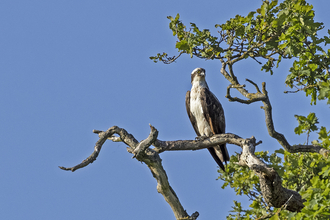
WOW Day 5: Wider Reintroduction Projects in the UK
Today is the final day of World Osprey Week and is all about other reintroduction projects in the UK.

WOW Day 4: Migration
Day 4 of World Osprey Week is all about their migration - read this blog to find out more...
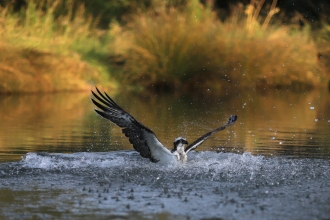
WOW Day 2: A History of Ospreys
Day 2 of World Osprey Week is all about the history of Ospreys in the UK!
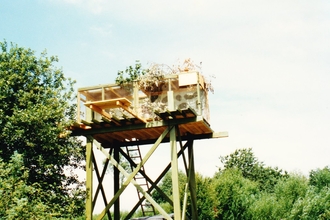
WOW Day 3: The Rutland Translocation Project
Day 3 of World Osprey Week is all about the Rutland Translocation Project, which ran between 1996 and 2001.
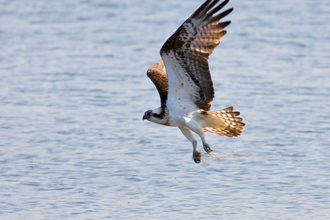
WOW Day 1: What is an Osprey?
This blog is part of a series of five, which are aimed at our younger audience for World Osprey Week! This blog is all about what an…
Osprey Leaders
Why not join the Osprey Leaders at Rutland Water run by the Osprey Leadership Foundation? This a group for 8 - 16 year olds who want to meet with like-minded peers to share their enthusiasm for nature (especially ospreys!) with each other and gain the confidence to become advocates for wildlife within their friends and family, schools, communities and beyond!

